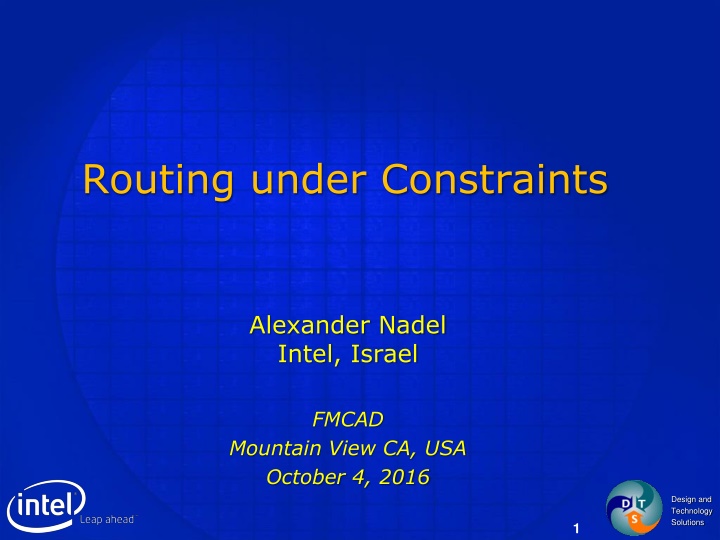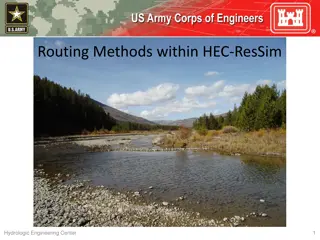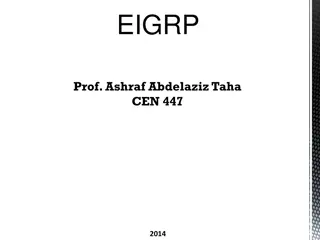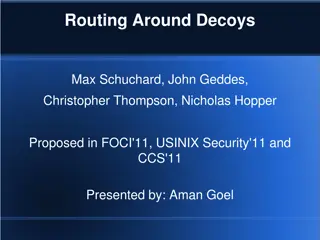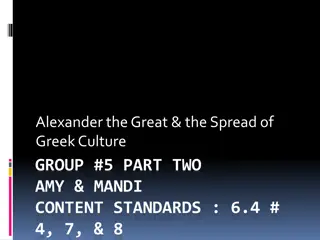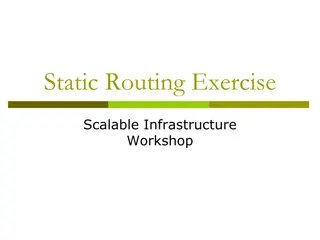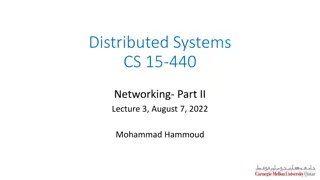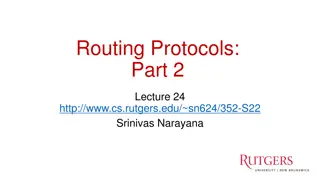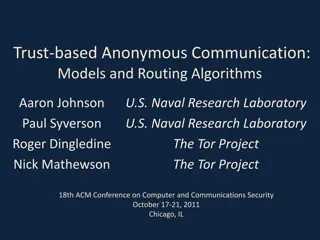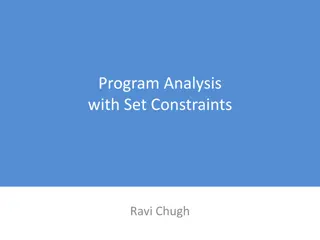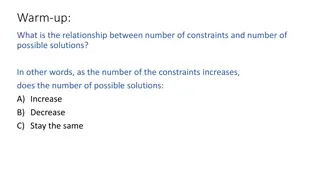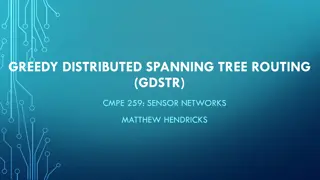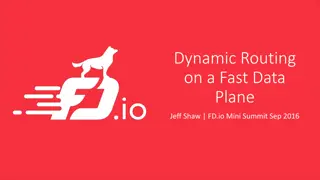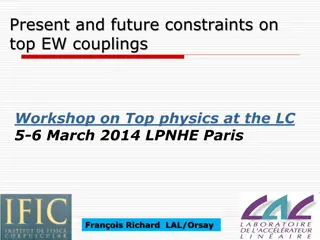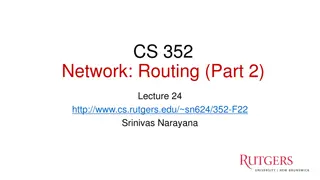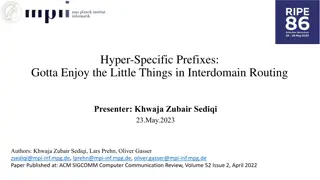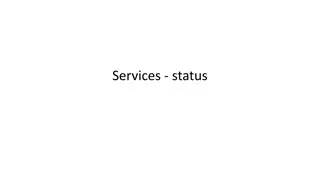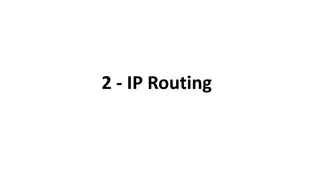Design Solutions for Routing under Constraints by Alexander Nadel
Alexander Nadel from Intel presents design solutions for routing under constraints, addressing challenges in formalization, scalability, decision strategies, conflict analysis, and violation resolution in industrial router design. The approach involves problem formalization, SAT encoding, net restarting, A*-based decision strategies, and conflict analysis to efficiently route unsolved instances in the industry. The process emphasizes design rule satisfaction, NP-hard output challenges, and industrial considerations like rip-up and reroute techniques to address violations and intersection issues in net routing.
Download Presentation

Please find below an Image/Link to download the presentation.
The content on the website is provided AS IS for your information and personal use only. It may not be sold, licensed, or shared on other websites without obtaining consent from the author.If you encounter any issues during the download, it is possible that the publisher has removed the file from their server.
You are allowed to download the files provided on this website for personal or commercial use, subject to the condition that they are used lawfully. All files are the property of their respective owners.
The content on the website is provided AS IS for your information and personal use only. It may not be sold, licensed, or shared on other websites without obtaining consent from the author.
E N D
Presentation Transcript
Routing under Constraints Alexander Nadel Intel, Israel FMCAD Mountain View CA, USA October 4, 2016 Design and Technology Solutions 1
Routing Design and Technology Solutions 2 "PhysicalDesign" by Linear77 - Own work. Licensed under CC BY 3.0 via Wikimedia Commons - https://commons.wikimedia.org/wiki/File:PhysicalDesign.png#/media/File:PhysicalDesign.png 2
Outline Goal: Design a Scalable Design Rule-aware Router Routing under Constraints (RUC): Problem Formalization Bit-Vector / SAT Encoding Doesn t scale DRouter through SAT Solver Surgery A*-based decision strategy (emulates constraints!) Net restarting & net swapping Graph conflict analysis Unsolved crafted and industrial RUC instances are routed! Design and Technology Solutions 3 3
Abboud et al, OR Spectrum08 Design and Technology Solutions 4 4
Routing: Input (AKA Steiner Tree Packing Problem) Input A graph G(V,E) Disjoint Nets Ni V Terminals Design and Technology Solutions 5 5
Routing: Output It is NP-hard to find: 1. Shortest solution for one multi-terminal net (Steiner tree problem) Output Input 2. Any solution for many multi-terminal nets 1. Each net is spanned by a tree, called the net routing 2. Net routings can t intersect 3. Optimization: minimize the total routing length Design and Technology Solutions 6 6
Design Rules Routing is to satisfy design rules Originating in the manufacturing requirement Example short rule: The 2 vertices of any edge can t belong to two distinct net routings Short rule is violated for these edges When the short rule is on, this example is UNSAT Design and Technology Solutions 7 7
Industrial Approach: Rip-Up and Reroute Nets are routed one-by-one Using A* s-t shortest-path given costs under-approximation A* Dijkstra if no costs under-approximation is provided Trying to heuristically obey design rules Violations are allowed, hence the initial solution might be problematic Net routings might intersect Design rules might be violated Clean-up is applied Rip-up: problematic net routings are removed Reroute: un-routed nets are attempted again Design and Technology Solutions 8 8
The Problem with the Current Solution Design rule violations persist Manual clean-up is carried out Some violations still persist Time-to-market is impacted Design and Technology Solutions 9 9
Potential Solution Constraint Solving Next: formalizing Routing under Constraints Design and Technology Solutions 10 10
Routing Induces Assignment Edge variables Bool e: edge activity Design and Technology Solutions 11 11
Design and Technology Solutions 12 12
0 1 1 0 0 0 0 0 0 0 0 0 0 0 0 1 1 0 0 0 0 0 0 0 0 0 0 0 0 0 0 0 1 0 1 1 0 0 0 0 0 0 0 0 0 0 0 0 0 0 0 1 0 1 1 0 0 0 0 0 0 0 0 0 0 0 0 0 0 0 1 0 1 1 0 0 1 0 0 1 1 1 1 1 1 0 0 0 0 1 0 0 0 0 0 0 0 0 0 0 0 0 0 0 0 0 0 0 1 0 0 0 0 0 0 0 0 0 0 0 0 0 0 0 0 0 0 1 0 0 0 0 0 0 0 0 0 0 0 0 0 0 0 0 0 0 1 0 0 0 0 0 0 0 0 0 0 0 0 0 0 0 0 0 0 1 0 0 0 0 0 0 0 0 0 0 0 0 0 0 Design and Technology Solutions 13 13
Routing Induces Assignment Vertex variables Bool v: activity status Bit-vector n: net id ( for inactive vertices) Design and Technology Solutions 14 14
Design and Technology Solutions 15 15
0, 0, 0, 0, 1,0 0, 0, 0, 1,0 1,0 0, 0, 0, 0, 1,0 0, 0, 0, 1,1 1,0 0, 0, 0, 0, 1,0 0, 0, 0, 1,1 1,0 0, 0, 0, 0, 1,0 0, 0, 0, 1,1 1,0 1,0 1,0 1,0 1,0 1,0 1,1 1,0 1,0 1,0 1,0 0, 0, 0, 0, 0, 1,1 0, 0, 0, 0, 0, 0, 0, 0, 0, 1,1 0, 0, 0, 0, 0, 0, 0, 0, 0, 1,1 0, 0, 0, 0, 0, 0, 0, 0, 0, 1,1 0, 0, 0, 0, 0, 0, 0, 0, 0, 1,1 0, 0, 0, 0, Design and Technology Solutions 16 16
Modeling Routing under Constraints Design rules can be easily expressed in BV logic Variables: Edge & vertex activities Vertex nids Any auxiliary variables Short rule example For every edge e=(v,u): v u nid(v)=nid(u) Short rule is violated for these edges Design and Technology Solutions 17
Routing under Constraints (RUC): Problem Formulation Input A quantifier-free bit-vector formula F(V E N A) - V : vertex activity - E : edge activity - N : vertex net id - A : any auxiliary variables (represents the design rules) 1. Graph G(V,E) 2. Disjoint Nets Ni V Output: a model to F, which induces a routing: - e=(v,u) is active - v and u are active, and - nid(v) = nid(u) - For each net i: active vertices with nid i and active edges span the net s terminals - Optional optimization requirement: the overall weight of active edges is as small as possible Design and Technology Solutions 18 18
Solving Attempt: Encoding into Bitvector Logic / SAT For 2-terminal nets: - e=(v,u) is active - v and u are active, and - nid(v) = nid(u) A terminal has one active neighbor edge An active non-terminal has two active neighbor edges For n-terminal nets: Encode directed trees Using edge directions Design and Technology Solutions 19 19
SAT Solvers Internals Boolean Constraint Propagation No conflict Decision Strategy (Conflict-driven) Conflict Analysis & Learning Time-to- restart? Backtracking Restarts Design and Technology Solutions 20 20
SAT DRouter through Surgery Design and Technology Solutions 21 21
SAT DRouter Boolean Constraint Propagation No conflict Decision Strategy (Conflict-driven) Conflict Analysis & Learning A*-based Router Graph-based Learning Time-to- restart? Time-to-flip? Time-to- restart? Backtracking Net Net Swapping Restarting Restarts Design and Technology Solutions 22 22
DRouter Encoded constraints: 1. Edge consistency e=(v,u) is active v and u are active nid(v) = nid(u) Boolean Constraint Propagation 2. User-provided constraints modelling design rules That s it! What about disconnected terminals??? No conflict Decision Strategy (Conflict-driven) Routing correctness is guaranteed by the decision strategy! Conflict Analysis & Learning A*-based Router Graph-based Learning Time-to- restart? Time-to-flip? Backtracking Net Net Swapping Restarting Design and Technology Solutions 23 23
1-Net Example Boolean Constraint Propagation No conflict Decision Strategy (Conflict-driven) Conflict Analysis & Learning A*-based Router Graph-based Learning Time-to- restart? Time-to-flip? Backtracking Net Net Swapping Restarting Design and Technology Solutions 24 24
1-Net Example s: (0, 0) t: (3, 0) (sugg.) 2 Real path (1,0) (2,0) (1,0) (1,1) (3,2) (3,1) x Design rules 1 Initial path: A* from s->t SAT x Decision 0 1 2 3 Path Suggestion (not an actual SAT decision) Activate edge in sugg. -violation A* search for new Design and Technology Solutions 25
1-Net Example BCP s: (0, 0) t: (3, 0) (sugg.) 2 Real path (1,0) (2,0) (1,0) (1,1) (3,2) (3,1) x 1 Initial path: A* from s->t Repeat x 0 1 2 3 Activate edge in sugg. No -violation Path found no Target is part of path? A* search for new Design and Technology Solutions 26
1-Net Example s: (0, 0) t: (3, 0) (sugg.) 2 Real path (1,0) (2,0) (1,0) (1,1) (3,2) (3,1) x x 1 Initial path: A* from s->t Repeat x 0 1 2 3 Activate edge in sugg. -violationNo -violation no Target is part of path? A* search for new Design and Technology Solutions 27
1-Net Example x s: (0, 0) t: (3, 0) (sugg.) 2 Real path (1,0) (2,0) (1,0) (1,1) (3,2) (3,1) (2,0) (3,2) x x 1 Initial path: A* from s->t Repeat x 0 1 2 3 Activate edge in sugg. 1UIP conflict clause: (2,0) (3,2) No -violation Add conflicting clause: vertex cut (2,0) (3,1) -violation no Target is part of path? A* search for new Learn & Backtrack Design and Technology Solutions Graph conflict (s and t can t be connected) 28
1-Net Example x s: (0, 0) t: (3, 0) (sugg.) 2 Real path (1,0) (2,0) (1,0) (1,1) (3,2) (3,1) (2,0) (3,2) x 1 Initial path: A* from s->t Repeat x 0 1 2 3 Activate edge in sugg. Result: Path that follows constraints! No -violation -violation Path found no Target is part of path? A* search for new (yes!) Learn & Backtrack Design and Technology Solutions DONE! Graph conflict 29
Multiple Nets Handling Route the nets one-by-one Order is critical! Example Order 1: Violet Black Red Example Order 2: Red Black Violet Design and Technology Solutions 30 30
Multiple Nets Handling - black is blocked - Early conflict detection - Check for graph conflicts after routing each terminal - Learn a conflict clause & re-route - Graph conflict Route the nets one-by-one Order is critical! Example Order 1: Violet Black Red Example Order 2: Red Black Violet Too slow! Solution: dynamic net reordering! Design and Technology Solutions 31 31
DRouter Boolean Constraint Propagation No conflict Decision Strategy (Conflict-driven) Conflict Analysis & Learning A*-based Router Graph-based Learning Time-to- restart? Time-to-flip? Backtracking Net Net Swapping Restarting Design and Technology Solutions 32 32
Net Swapping Example Order 2: Red Black Violet Flip: Black Red Violet Swapped Net Swapping: After N conflicts, swap the order between: the first blocked net i the blocking net j {A,j,B,i,C} {A,i,j,B,C} Design and Technology Solutions 33 33
Net Restarting Example Order 2: Red Black Violet Flip: Black Red Violet Moved to the top Net Restarting Restart and move the blocked net to the top (after M conflicts for that net) Design and Technology Solutions 34 34
Net Swapping vs. Net Restarting Swapping is local Restarting is global In practice both techniques are crucial Strategy: Swap for some time If it doesn t work, restart Design and Technology Solutions 35 35
Related Work 1: Clock Routing Erez & Nadel, CAV 15 Reduction to finding bounded-path in graph SAT solver surgery: graph-aware decision strategy & graph conflict analysis The decision strategy: Emulates constraints! Guides the solver towards the solution Considers additional optimization requirements Clock Routing Design and Technology Solutions 36 36
Related Work 2: Monosat Solver Bayless & Bayless & Hoos & Hu, AAAI 15 Can reason about graph predicates & SAT/BV Graph conflict analysis Shortest-path decision heuristic can be optionally applied Path-finding (routing for one 2-terminal net) is conceptually similar in Monosat and DRouter Main difference: Lazy A* in DRouter vs. Eager incremental Ramalingam-Reps in Monosat RUC can be easily expressed in Monosat language Design and Technology Solutions 37 37
Monosat vs. DRouter for Routing under Constraints Monosat s algorithms are not routing-aware No net re-ordering Graph conflict analysis for routing is inefficient Routing in DRouter (net swapping&restarting are off) Routing in Monosat Conflict Conflict Design and Technology Solutions 38 38
Experimental Results on Crafted Instances Solvers: Drouter (default) Drouter R: no net restarting Drouter S: no net swapping Drouter SR: no net swapping, no net restarting Monosat (default) Monosat + D: shortest-path decision strategy is on BV: reduction to BV Instances: 120 solid grid graphs of size M 20 M {3,5,7} 20 random 2-terminal nets Generate C * |V| random binary clauses v u v,u V C {0,0.1,0.2,0.3} Design and Technology Solutions 39 39
30 25 DROUTER DROUTER-R DROUTER-S DROUTER-SR MONOSAT MONOSAT+D BV 20 # SOLVED 15 10 5 0 0 10 20 30 - Full-fledged DRouter only can solves all the instances - Both net restarting and net swapping are essential! Monosat and BV can t solve a single instance - Design and Technology Solutions 40 40
DRouter on Industrial Instances Run DRouter on difficult clips from Intel designs Couldn t be routed cleanly by 2 industrial routers Nets Vertices Constraints Time in sec. Memory in Gb. Area in m2 24 110 42,456 484,008 25 0.7 24 230 42,456 484,008 391 1.0 32 352 63,740 667,764 705 2.2 129 788 127,480 2,669,056 14,733 6.5 129 891 127,480 2,669,056 92,950 6.5 Design and Technology Solutions 41 41
Conclusion DRouter: design-rule-aware router SAT solver surgery: Decision heuristic A*-based router Conflict analysis enhanced with graph reasoning Restarts net swapping & net restarting Solves instances which can t be solved by existing tools Including clips from real Intel designs Design and Technology Solutions 42 42
